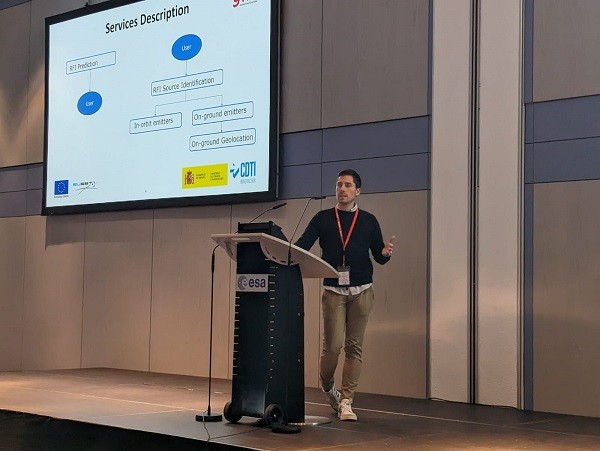GMV shows ESA its commitment to space sustainability

As proof of its staunch commitment to space security and sustainability, GMV attended the 2nd ESA NEO and Debris Detection Conference, held in Darmstadt, Germany, from January 24 to 26. The growing number of objects orbiting the Earth could pose a serious threat, making space security a growing concern. As a world leader in studying, monitoring, and preventing the proliferation of space junk, a market in which it has been operating for over 20 years, GMV attended the conference organized by the European Space Agency (ESA), which focused on the progress made in this field after exploring the synergies between search programs, orbit determination, and risk management for NEO and space objects.
Diego Escobar Antón, head of GMV’s SST Systems Southern Europe, Technical Coordination and Products (S3T) division of EST Space Systems, took part in the panel “Better together—highlights and prospects for NEO and debris detection in observation networks,” giving his vision and experience in studying and detecting space debris, focusing on the opportunities offered by today’s data networks and their relevance for supporting sustainability and space security.
As well as Diego Escobar, GMV was represented at the ESA-organized conference by several space-debris experts, including Estefanía Padilla, engineer of the Clean Space initiative, launched in 2012 to guarantee the future of space activities and ensure environmental protection (both on the ground and in orbit). Estefanía Padilla gave a talk on “Satellite laser ranging for attitude determination and D4R to enable ADR of future space debris,” the aim of which was to give an overview of the D4R technologies being developed by the Clean Space initiative supported by the space industry (GMV among others), focusing on the cornercube reflectors that are expected to form part of these technologies to facilitate attitude determination from the ground using SLR as an observation strategy.
D4R is required to enable ADR for future satellites, both when the satellite is still operational and when it has failed and become space junk. In the latter case, attitude determination from the ground is crucial to determine the attitude of space debris before launching a chaser so that it can be determined whether space debris could be captured or, conversely, to save money by avoiding an unnecessary launch. This work is particularly important for GMV, which is working with Clean Space to develop the D4R capture interface (MICE) and also on the active servicer part through the CAT activity.
Also attending the 2nd ESA NEO and Debris Detection Conference was Marc Belmonte, Space Surveillance & Traffic Management Engineer, who gave a presentation on “Passive ranging solution design to maintain a catalog of active objects in GEO.” In this presentation, GMV presented a project carried out under a contract with the Industrial Technical Development Center (Centro para el Desarrollo Técnico Industrial: CDTI), in which it studied the feasibility of maintaining a catalog of active satellites in GEO orbit using Passive Ranging (a cataloging technology based on the relative difference in the arrival time of a signal emitted by an active satellite, usually satellites in geostationary orbit, and received at different ground stations) and the effect of adding this technology (characterized by lower latency and higher accuracy than traditional SST services such as radar or optical observations) to a collision avoidance service.
Adrián Hernández, a Flight Dynamics and Operations Engineer working at SST&STM (Space Surveillance and Tracking & Space Traffic Management), participated in the talk on “New STM services: Radio-Frequency Interference Events Detection, Characterisation and Source Identification," in which EUSST presented new STM (Space Traffic Management) services focused on predicting, characterizing and identifying sources of Radio Frequency Interferences (RFI). The presentation focused on how these new services can help satellite operators in their daily operations by allowing them to anticipate this type of interference and assist them in taking mitigation action.
Laura Aivar, GMV’s project manager for the company’s ESA activity in collaboration with DIGOS, a leading German company in laser-ranging satellites, took part in the conference “SLR - Evolution towards active sensor networking for debris observation including updating the Izaña-1 station,” in which she discussed the collaboration between the two companies, whose objectives are to upgrade the IZN-1 laser station in Tenerife to track space debris and develop an online platform to program a network of laser sensors and use the measurements taken to produce products such as refined orbits, re-evaluation of collision risks and re-entry events, sensor calibration and object catalog maintenance.
Alejandro Pastor, GMV’s Space Surveillance & Tracking Systems Engineer, presented the paper “Improving orbit prediction via thermospheric density calibration,” which showed a novel approach to assimilating thermospheric density observations into atmospheric models to improve the accuracy of orbit predictions in short- and medium-term propagations. He also presented “A multiple target tracking filter for non-cooperative space objects,” with which the company proposed using computationally efficient control distance metrics for maneuver estimation.
GMV also participating on behalf of GMV were:
- Alejandro Cano in “Covariance propagation and determination with time-correlated errors.”
- George Dan in “Automated Collision Risk Assessment and Mitigation.”
- Bogdan Bija in “Gendared: the Generic Data Reduction Framework for Space Surveillance.”
- Felix Stechowsky in “Achievable orbit estimation accuracy through space-based passive optical observations: a sensor requirement analysis.”